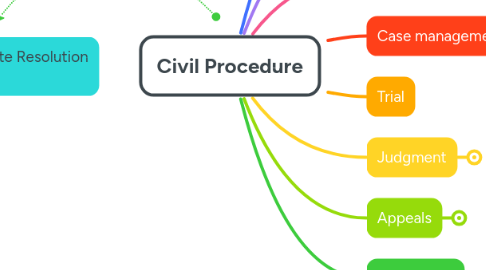
1. Alternative Dispute Resolution (ADR)
1.1. types of ADR
1.1.1. negotiation
1.1.2. mediation
1.1.3. conciliation
1.1.4. arbitration
1.2. utility of ADR
1.2.1. party control
1.2.2. flexible outcomes
1.2.3. speed and cost in ADR
1.2.4. soft skills and emotional intelligence
1.3. enforcing ADR agreement
1.3.1. contracts
1.3.2. consent judgment
2. Considering the dispute
2.1. exploring the dispute
2.1.1. learning about your client's story
2.1.2. considering documents
2.2. identifying causes of action
2.2.1. elements of causes of action
2.2.2. identifying legally relevant facts
2.2.3. exploring possible evidence
2.3. establishing a lawyer/client relationship
2.3.1. ethical and professional rules
2.3.2. costs agreements
2.3.3. confidentiality
2.4. considering resolution strategies
2.4.1. ADR v litigation
2.4.1.1. ethical obligations
3. Pre action steps
3.1. jurisdiction
3.1.1. statutory claims
3.1.2. common law claims
3.1.3. remedies and quantum of damages
3.1.4. challenging jurisdiction
3.1.4.1. cross vesting
3.1.4.2. forum non conveniens
3.2. pre action steps
3.2.1. letters
3.2.2. offers
3.2.3. personal injury matters
3.2.4. pre action meeting
3.3. consequences of non compliance
3.3.1. directions hearing
3.3.2. costs
3.4. considering settlement
4. Developing a claim or defence
4.1. rules of pleadings
4.1.1. pleading consistent facts
4.1.2. managing the unknown by pleading in the alternative
4.1.3. not pleading law or evidence
4.1.4. precision
4.1.5. ethics and pleading
4.1.5.1. pleading allegations of criminality or fraud
4.2. how pleadings shape trial
4.2.1. bringing evidence of matters not pleaded
4.2.2. discovery of documents directly relevant to pleaded issues
4.3. responding to issues in pleadings
4.3.1. strike out
4.3.2. summary judgment
4.3.3. application for further and better particulars
4.3.4. communication with other parties requesting amendment
4.4. admissions
4.4.1. withdrawal of admissions
4.4.2. cost consequences of failing to admit
4.5. amending pleadings
4.5.1. as of a right
4.5.2. with leave of the court or consent
4.5.3. in response to discovered documents
4.5.4. to make new documents directly relevant
4.6. discovery of documents
4.6.1. rules of discovery
4.6.1.1. general discovery
4.6.1.2. specific discovery
4.6.1.3. discovery by category
4.6.2. directly relevant documents
4.6.2.1. determined by the pleadings
4.6.3. preparing and exchanging lists of documents
4.6.4. production of documents
4.6.4.1. confidentiality
4.6.4.2. immunity
4.6.4.3. privilege
4.6.5. enforcing discovery obligations
4.6.6. use of discovered documents
5. Case management
5.1. interlocutory applications
5.2. directions hearings
5.3. responsible use of court process
5.4. ethical obligations in case management
5.5. types of applications
5.5.1. Investigations and gathering evidence
5.5.1.1. investigations
5.5.1.2. testing
5.5.1.3. medical testing
5.5.1.4. experts
5.5.1.5. shadow experts
5.5.1.6. third party discovery
5.5.1.7. subpoenas
5.5.1.8. notices to admit
5.5.2. Maintaining the status quo
5.5.2.1. injunctions
5.5.2.2. mareva orders
5.5.2.3. search orders
5.6. costs of interlocutory applications
5.6.1. costs orders
5.6.1.1. when costs orders are made
5.6.1.2. purpose of costs orders
5.6.1.3. party/party costs
5.6.1.4. court scales
5.6.2. usual costs orders
5.6.2.1. costs in the cause
5.6.3. exceptional costs orders
5.6.3.1. types of exceptional costs order
5.6.3.1.1. solicitor/client costs
5.6.3.1.2. indemnity costs
5.6.3.1.3. costs in public interest matters
5.6.3.1.4. costs orders against solicitors
5.7. managing party conduct
5.7.1. costs
5.7.2. contempt
5.7.3. stays
5.7.4. default judgment
5.8. readiness for trial
5.8.1. evaluating readiness
5.8.2. certificate of readiness
5.8.3. consequences of certificate of readiness
